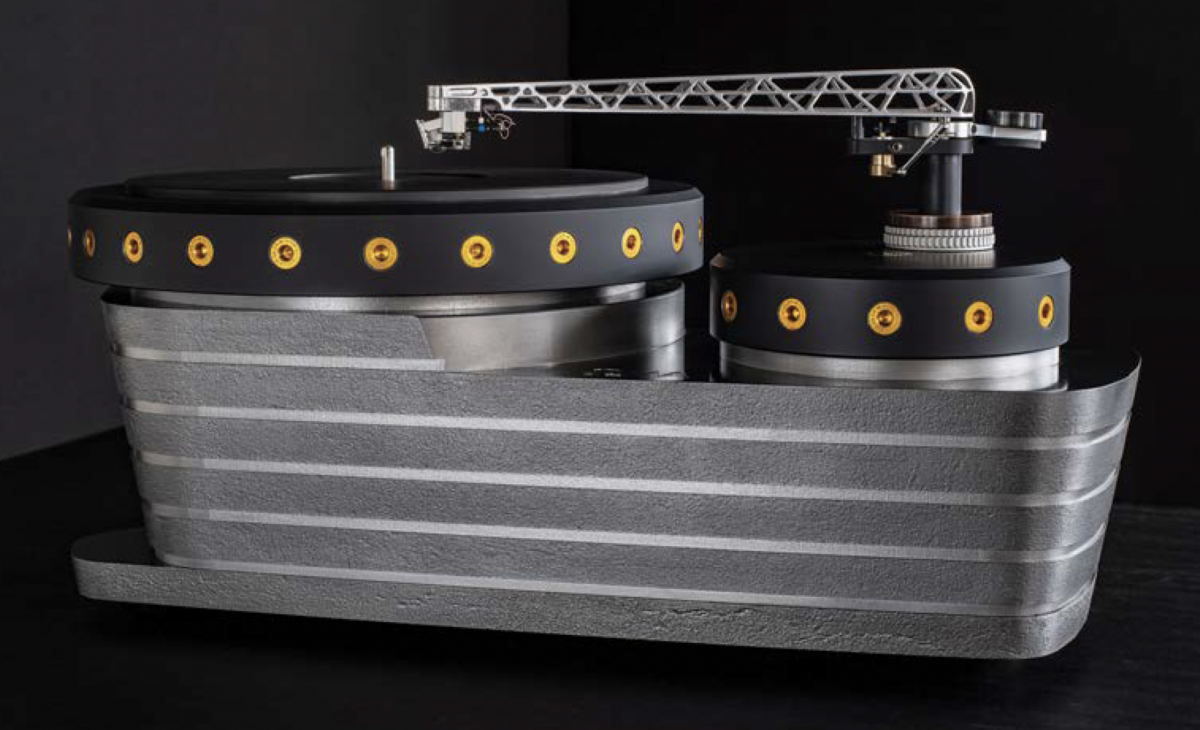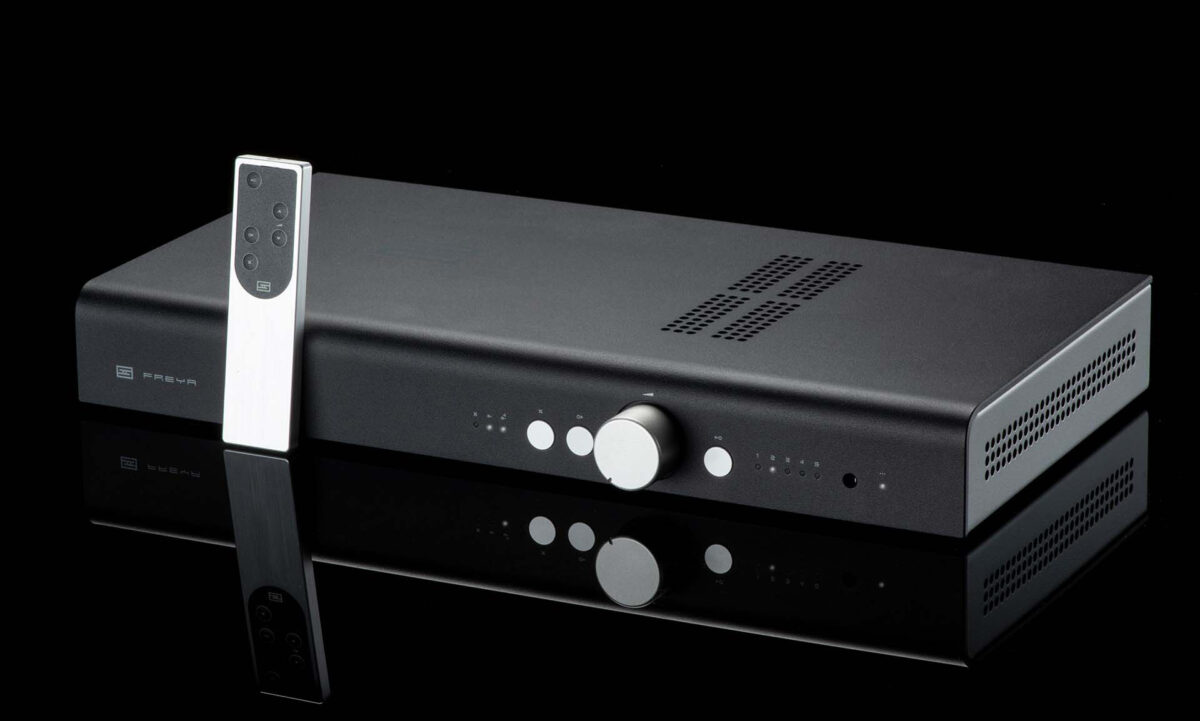
Completed in 2018, the Statue of Unity, in the Gujarat region of India, is the largest statue in the world. It stands 597 feet tall, almost four times taller than the Statue of Liberty. If the Statue of Unity had shoes on its feet (which it does not), I would imagine the shoehorn it would use to slip said foot into said shoe would be about the same size as the shoehorn that the engineers at NAD used to cram the volume of functionality, refinement, and performance into the M10, an all-in-one component that measures 8.5″ x 4″ x 10.25″. And since I’ve gone this far, it is also fascinating to note that although the Statue of Liberty is ranked the 49th tallest statue in the world, it is in fact, the largest statue in the world to wear shoes, or sandals in Lady Liberty’s case.
The $2749 M10 came from the minds of NAD’s Masters Series engineers when challenged to reimagine their Bluesound PowerNode—a wireless amplified multi-room streaming music system. Through their distribution partners came requests from customers who wanted a PowerNode with more refinement, more power, a better DAC, more connectivity, a better display, and no plastic—more of a premium product. NAD’s response was to refashion the PowerNode into a compact Masters Series component to satisfy their customers’ needs for simplicity, premium performance, and elegance. Although functionally similar to the Bluesound PowerNode, it shares more technology with the NAD Masters Series M32, M12, and M22 components. It is an all-in-one unit and houses everything needed to make speakers speak; just add transducers and cables and you’ve got yourself a super-spouse-friendly audio system.
So, What’s in The Box?
Fabricated with an extruded aluminum chassis with Gorilla Glass on the top and front panel, this half-rack component is simple in design yet finished with luxury in mind. The front is a large touchscreen covering all but a thin bezel, and the top houses a beautiful lighted logo that indicates power status. This is the all-in-one that Jean-Luc Picard would unquestionably have in his ready room on a table just below his fish tank, sitting beside a steaming cup of Earl Grey tea. There is a small standby button on the back left, along with a set of high-quality speaker binding posts and an assortment of RCA inputs and outputs, digital inputs, an HDMI input, a USB data slot used for the room-correction microphone, an Ethernet port, and an IEC for power. This is a unit that can live in plain view in any home without complaints or threats of violence from your significant other.
The touchscreen displays cover art and song title, while also indicating digital sources or displaying a digital VU meter when other inputs are engaged. The screen also allows for track selection, volume control, all setting adjustments, and menu control. It is intuitive and large enough for middle-aged eyes to see and read without seeking out your most powerful pair of reading glasses. Software is of the Linux-based BluOS variety, running on an NXP 1GHz ARM processor. BluOS excels at integrating audiophile-grade hardware with both local and Cloud-based storage and services. Controlled from the app (available on all popular portable platforms including Windows and MacOs), BluOS allows you to control any BluOS or Roon-enabled device to create a multi-room music experience that is simple and intuitive. BluOS is compatible with Roon, Airplay2, Amazon, Spotify, Tidal, Qobuz, and about 15 other services, although it doesn’t support Chromecast. And its Roon integration is seamless and reliable.

NAD chose the ESS Sabre DAC chip utilizing 32-bit Hyperstream DAC architecture and the Time Domain Jitter Eliminator. NAD also implements an ESS 9028 programmable output filter, which allows for MQA compatibility and fine-tuning. The system is 24/192 PCM-compatible and supports FLAC, WAV, MP3, AAC, and the other usual compressed audio suspects. Bluetooth aptX HD is standard and can be used to listen from Bluetooth-enabled headphones and speakers. There is, however, no physical headphone jack, so Bluetooth is your only option for a personal listening session.
The M10 supports multiple analog and digital inputs. For TV viewers, the HDMI input supports the Audio Return Channel (ARC), allowing TV integration for both sound and control. A future software update may provide compatibility with eARC (Enhanced Audio Return Channel) that will seamlessly transfer hi-res audio without need for a separate cable. Each of the inputs can be custom-labeled and/or disabled to simplify everyday use. In addition, all local sources into the M10 are available across the entire BluOS network. The M10 is equipped with a preamp output and a user-defined mono or stereo subwoofer output with crossover point adjustment within the software. This was enormously useful as many of the speakers one would be inclined to use with the M10 benefit from implementing a subwoofer or two, which I did on several occasions to wonderful effect.
The amplifier module is a Hypex nCore Class D design. As audiophiles, we collectively need to stop tightening our sphincters when we read or hear Class D; in 2019 Class D simply isn’t what is was when Class D subwoofer and car amplifiers came out over a decade ago. Companies like Rowland, Mola Mola, MBL, and Merrill Audio have taught us that Class D can be class-leading. NAD utilizes a self-oscillating clock design implementing multiple nested feedback loops, resulting in nearly immeasurable noise and distortion and avoiding the crossover notch found in many Class AB amplifiers. And the Hypex nCore design is “load invariant,” including the output filter in the feedback loop, thus keeping the frequency response flat from top to bottom. All this Class D technology gives the user 100Wpc into 8 ohms with up to 300Wpc into 4 ohms on a dynamic basis. My volume control lived between 50 and 75 on sensitive speakers and 75 to 93 on less sensitive ones.
I feel like the old Ginsu knife commercial right now—“But wait! There’s more!”
Along with the myriad features just described, NAD used its giant shoehorn to implement a rather sophisticated, robust, and effective room-correction system, Dirac Live LE. The general gist is that you hold the supplied USB-connected microphone in several different positions near the listening seat for the system to measure the response of your speakers in your room at your speaker and listener positions. It then sends those measurements off to the Cloud and loads the time- and frequency-corrected filters directly into the M10. The Dirac system that comes with the M10 corrects frequency response peaks and dips up to 500Hz, but more sophisticated “upgrades” are available for purchase for very complex rooms, or if you utilize multiple subwoofers. The Dirac correction is applied to both digital and analog inputs. This is all controlled from a free app that found the M10 instantly when I started the software. My first effort with room correction was less than seamless, but after that it worked without issue, which makes me think it was user error. I suggest you invest in a pair of earplugs while the process is underway, and set aside some time. The results are more than worth the effort and make what is already a very good performer a great performer—and a killer deal for the price of admission. Dirac correction adds tighter bass control with more heft and impact while avoiding bloat, and gives the midrange more flesh and richness while avoiding warm coloration. It also tames any high-frequency peaks or beaming that an overly reflective room can create.
Why an All-in-One?
With so much budget-priced audio equipment out these days, what’s the advantage of an all-in-one when everyone knows separates give better performance? You know the answer to that question before you ask it. If you want the performance of separate components and are inclined to pursue the power conditioners, cables, and storage space they demand, then you can wear your Audiophile badge with pride. But if you have a lovely family room or living room or office and want good music there (I mean, really good music), and don’t want to settle for the Bose system that your spouse keeps telling you sounds good enough, then you need to pay attention because the M10 is what you need. Yes, that was a run-on sentence; but I meant to run on about this! Kii speakers will get you there, but they are way more expensive. Products from Naim and Linn will get you there, but to add room correction will double the price. Less expensive all-in-one speakers will get you there, like Elac’s new offering, or Vanatoo’s; and they will sound good but still not offer room correction nor the finesse, luxury, or flexibility the M10 provides. Can you get better audio performance for another $1000–$1500? Possibly. Will that performance outweigh spending that same amount more on speakers? No, it won’t.
Sounds Like?
To reiterate, Class D does not stand for Dismal or Dull or Despicable or Depressing; and Class AB doesn’t mean Absolutely Better. To spoil the surprise, this unit is sonically exceptional for what it is and all it does, especially once the room correction is implemented. The M10 has enough power to easily manage my 87dB-sensitive Evolution Acoustics MMMicroOne and Elac Debut 2.0 B6.2, sings with the 96dB-sensitive Klipsch RP-600M and 101dB-sensitive Zu Audio Druid V, and is just barely enough for the mighty Dynaudio Consequence Ultimate (which was a totally ridiculous combination but worth a try). I’d stick with 87dB and up, and the M10 will have no issues offering proper dynamic performance, control of the drivers, and the ability to rock da’ house when called upon.
Tonally the M10 is a bit of a chameleon, embracing the sonic attributes of the speaker it’s connected to. At first, I thought the M10 to be a hair on the soft side of neutral driving the Elac and Zu speakers. Yet the MicroOne’s more meticulous presentation and the Klipsch’s higher sensitivity and sense of exuberance made me second guess that first impression. To me, this is a telltale sign that I was dealing with a strong foundation upon which I could build a wonderfully simple, transparent, and enjoyable system to my (or your) taste. Yet no matter what speaker I connected, the M10’s ability to reproduce complex harmonics and textures always surprised me, as did its low-energy reproduction. To be flatly honest, I wasn’t expecting much, with everything including the kitchen sink shoehorned into this little box of refined goodness. I was proven very wrong. Mark Knopfler and James Taylor’s Sailing to Philadelphia offered luscious guitar harmonics and low-frequency tonality, and a well-placed duet between two amazing singers properly placed in my x, y, and z axes. Yup, wasn’t expecting that…. Pink Floyd Welcomed Me to Their Machine with a generous sense of dynamic control, pace, and rhythm. And Liszt’s Hungarian Rhapsody No 2 whisked me to a time in my past when Tom and Jerry battled over the ebonies and ivories, first introducing me to that wonderful classical composition. No matter the source material and no matter the source, the Masters Series M10 allowed me to tap my toes and enjoy the music, all from the comfort of my couch with total control from my handy and accessible iPhone.
As we all know, equipment and system matching is 50% of the equation, speaker setup is 25%, and the room itself is another 35%. That’s right, 110%! Room correction allows us to remove 10%, leaving us 100% of our daily recommended allowance of audiophile sustenance. I can connect a pair of speakers to the M10 that makes the listener condemn the Class D amp as disappointing, or I can spend some time taking advantage of what the M10 can do and find the speakers that make this all-in-one push my buttons. I can tell you that there are speakers from $250 to $7500 that can make the NAD M10 provide a system you can truly enjoy in the space you are trying to relax in.
I am relatively confident that the preamp outputs on the back of the M10 were placed there to facilitate a multi-zone audio system and not to add an external amplifier to improve the performance. Why, you ask? Because I asked NAD, and they told me that. But I tried it anyway because I could and should—to be thorough for and honest to you, our readers. I tried it with my Musical Fidelity TriVista 300 integrated (which has preamp outs, but I had modified to allow me to access the amplifier section with a new set of “Amp In” RCA’s) and with my Octave V80SE, which has both “Main In” and “Main Out” jacks on the back. As expected, performance was significantly improved. This doesn’t tell me that the internal amp is bad; it tells me that if someone ever decided to use this as a front end and add an external amplifier it would serve them very well.
Conclusion
Now, this is one of those reviews that challenges the foundation of the reviewer’s dichotomy. Am I reporting to you how this piece of equipment performs in comparison to itself and what it is clearly designed to accomplish? Or am I comparing this to the best system I have ever heard? To do the first without at least comparing it to similarly priced all-in-ones and separates would be irresponsible. To do the second would be, well, ridiculous; yet it is those systems that allow us to set a standard by which we judge all else. I believe that the NAD M10 accomplished its task and is a highly viable, if not unique, option at its price point and with its feature set. It is unabashedly not audiophile nirvana, nor is it the last word in accuracy or musicality. What it is is attractive, luxurious, simple to set up and use, small, ridiculously well featured, and wonderfully enjoyable to listen to when connected to the right speakers for your ears and budget.
The gents from NAD said this of their M10: “This is not an audiophile product, but it is using NAD Masters Series technology and experience to create sound that audiophiles would appreciate.” Mission accomplished, and highly recommended.
Specs & Pricing
Output power: 100Wpc into 8 or 4 ohms (continuous); 160Wpc into 8 ohms; 300Wpc into 4 ohms (dynamic power)
Analog inputs: Two unbalanced on RCA jacks
Analog outputs: Preamp out, subwoofer out (x2)
Digital inputs: Coax, TosLink, HDMI, LAN, USB
DAC: ESS Sabre, 384kHz/32-bit
Connectivity: AirPlay2, aptX Bluetooth, NFC, BluOS wireless streaming, Ethernet
Apps: iOS, Android, Mac OS, Windows
Room correction: Dirac Live
Dimensions: 8.5″ x 4″ x 10.25″
Price: $2749
NAD ELECTRONICS
Lenbrook Industries Limited
633 Granite Court
Pickering, Ontario L1W 3K1
Canada
(905) 831-6333
nadelectronics.com
ASSOCIATED EQUIPMENT
Preamplifier: Burmester 077 with DAC
Power amplifiers: Burmester 911 mk3 monoblocks
Integrated amplifiers: Musical Fidelity Trivista 300, Octave V80SE
Analog: VPI HW-40 with Lyra Atlas SL, Manley Steelhead phonostage
DAC: DaVinci Light Harmonic 2, Chord Hugo 2
Music server: Memory Player Transport 32 Core MP64, Bybee IQSEx2, SOTM USB card and reclocker with dedicated LPS
Loudspeakers: Dynaudio Consequence Ultimate, Laufer Teknik Porzilli Linear Array, Zu Audio Druid mk. V, Elac UniFi B5
Subwoofers: Vandersteen Audio Sub Three + M7-HPB
Power conditioner: Shunyata Research D6000s, Torus RM20BAL
Cables: Shunyata Research Z-Tron, Z-Ton Sigma, EnKlein David, Crystal Cable Absolute Dream and CrystalConnect Reference Diamond, Zu Libtec, Analysis Plus Big Silver Oval and Micro Golden Oval, Light Harmonic Lightspeed 20G USB, Wireworld Platinum Starlight
Equipment racks: Adona SR4 Rack, Adona Nemisis ALGC
Isolation: HRS Nimbus, Shun Mook Giant Diamond Resonator, Symposium Ultra 19×18 Shelf x 2, Symposium Rollerblocks 2+ double-stack x 3, IsoAcousics Orea Bourdeaux, IsoAcousics Gaia 1
AC: Custom dedicated lines, Furutech GTX-D-NCF Rhodium outlets x 4, EP-2750 ground filter (x4), EP-2050 surge/waveform correction panel conditioner
Acoustic treatments: GIK Soffit Traps (front corners), Tri Traps (rear corners) with scatter plates, Monster Trap with scatter plate and range limiter, Monster Trap full range, 244 trap with scatter plate x 3, Acoustic Wings, Auralex Waveprism x 8, T’Fusor x 4, Vicoustics Wavewood x 12, Multifuser DC2 x 12, Multifuser Wood 64 x 2, Super Bass Extreme x 8
Tags: STREAMING

By Matthew Clott
More articles from this editorRead Next From Review
See all
Oswalds Mill Audio K3 Turntable
- Apr 12, 2024

2023 Golden Ear: Schiit Freya S Preamplifier
- Apr 12, 2024




















